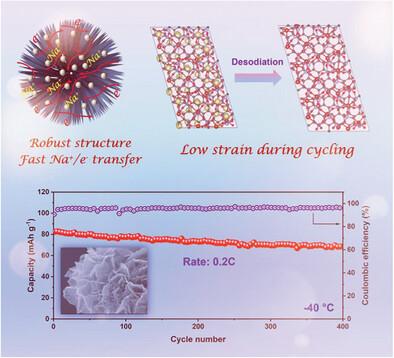片状Na3V2(PO4)3@Carbon球形超结构的固态自组装:大规模生产和提高低温Na存储能力
IF 12.1
2区 材料科学
Q1 CHEMISTRY, MULTIDISCIPLINARY
引用次数: 0
摘要
二次电池在宽温度范围特别是低温条件下的应用成为储能领域的研究热点。Na3V2(PO4)3 (NVP)因其坚固的结构和快速的钠离子传输而成为LT钠离子电池(sib)极具前景的阴极材料。然而,传统的NVP电极材料在低温下受到较差的本征电子导电性和界面劣化的阻碍,导致其倍率能力和使用寿命不理想。为了解决这些问题,研究人员开发了一种由片状Na3V2(PO4)3@carbon自组装成球形超结构复合材料(表示为SS-NVP@C)的固态自组装材料,作为超低温(- 40°C) sib的阴极。由于具有强大的自组装球形上部结构,增强了电子转移和快速的na离子传输,SS-NVP@C阴极表现出优异的倍率性能和延长的循环性能,特别是实用的LT适应性,包括0.1C时的92 mA h g−1比容量,5C时的51 mA h g−1的卓越倍率能力,以及在0.2C时400次循环保持84.8%的容量。此外,研究了SS-NVP@C的生长机理,为LT储能先进电极材料的材料设计和大规模生产提供了新的途径。本文章由计算机程序翻译,如有差异,请以英文原文为准。

Solid State Self-Assembly of Flaky Na3V2(PO4)3@Carbon into Spherical Superstructures: Large Production and Boosted Low-Temperature Na Storage Capability
The application of secondary batteries at wide temperature ranges, particularly at low temperatures (LT), becomes a hotspot in the energy storage field. Na3V2(PO4)3 (NVP) emerges as a prospective cathodic material for LT sodium-ion batteries (SIBs) due to its robust structure and fast Na-ion transportation. However, conventional NVP electrode materials are hindered by inferior intrinsic electronic conductivity and interfacial deterioration at LT, leading to unsatisfactory rate capability and service life. To address these challenges, a solid state self-assembly of flaky Na3V2(PO4)3@carbon into spherical superstructure composite (denoted as SS-NVP@C) is developed, which serves as the cathode for ultra-low temperature (−40 °C) SIBs. Owing to the robust self-assembly spherical superstructures with boosted electronic transfer and fast Na-ion transportation, the SS-NVP@C cathode demonstrates excellent rate performance and prolonged cyclability, especially pragmatical LT adaptability including specific capacity of 92 mA h g−1 at 0.1C, brilliant rate capability of 51 mA h g−1 at 5C, and remaining 84.8% capacity retention over 400 cycles at 0.2C. Furthermore, the growth mechanism of SS-NVP@C is fully investigated, providing a novel manner for the materials design and large-scale production of advanced electrode materials for LT energy storage.
求助全文
通过发布文献求助,成功后即可免费获取论文全文。
去求助
来源期刊

Small
工程技术-材料科学:综合
CiteScore
17.70
自引率
3.80%
发文量
1830
审稿时长
2.1 months
期刊介绍:
Small serves as an exceptional platform for both experimental and theoretical studies in fundamental and applied interdisciplinary research at the nano- and microscale. The journal offers a compelling mix of peer-reviewed Research Articles, Reviews, Perspectives, and Comments.
With a remarkable 2022 Journal Impact Factor of 13.3 (Journal Citation Reports from Clarivate Analytics, 2023), Small remains among the top multidisciplinary journals, covering a wide range of topics at the interface of materials science, chemistry, physics, engineering, medicine, and biology.
Small's readership includes biochemists, biologists, biomedical scientists, chemists, engineers, information technologists, materials scientists, physicists, and theoreticians alike.
 求助内容:
求助内容: 应助结果提醒方式:
应助结果提醒方式:


